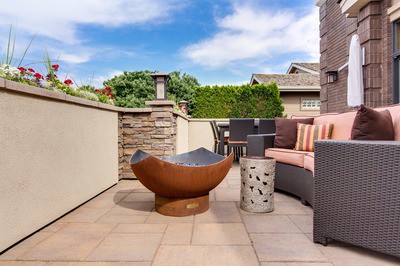If you are looking to build a patio onto your house, you need to take into account the slope of the land before starting your construction project. Planning needs to be done to make sure that the slope of the patio is correct. But what slope is correct and safe for a patio? Is it safe for the patio to slope toward the house, or is this a complete no-no?
It is not safe for a patio to slope towards the house. Water flowing towards the house can cause problems for the foundations of the house, the basement, the crawlspace and cause potential flooding. The recommended gradient for the patio to slope away from the house is a 2% drop in elevation.
In some cases, the slope of the land where you want to build your patio may be sloping toward the house, and you may wonder if you need to compensate for this. Is it acceptable for the patio to slope in this direction, or does it present some safety concerns for your house?
Which Way Should A Patio Slope?
When you plan the construction of your patio, you should always design it to slope away from the house. The main problem that is of concern is the drainage of rainwater. Some people may think that it would be sufficient to place a drain or a channel where the patio meets the house to direct the water flow away from the house.
Unfortunately, this type of drainage is often not sufficient to cater for large volumes of water, and you may get away with this solution for a season or two, but when you have a period of sustained rain, you may be in deep water, so to speak. Even a clogged drain can play havoc and reduce the volume of flow.
We will mention a few potential problems that could arise as a result of a patio sloping towards your house, which will give you sufficient proof that the right way for a patio to slope is away from your house.
Problems With A Patio Sloping Towards The House
When a patio slopes towards your house, it directs any water or moisture that lands on the patio towards your house. Depending on the construction type and style of your house, this could result in a number of potential problems to the safety of your house and your family who live in it.
The Effect On The Foundations Of Your Home.
Water that is constantly directed towards your foundations can lead to significant problems for your home, both from a structural integrity point of view and from a health point of view.
Water at the foundations can lead to rising damp issues, which can result in maintenance problems with paint blistering on the walls and peeling off as well as the introduction of mold to the home.
The foundations could also be undercut by the water, and the footing washed away, which will lead to walls cracking and structural problems that may be expensive, requiring the services of an engineer to rectify the problem.
The Effect On Your Basement
If your home is constructed with a basement or other rooms that are below ground level, then water that is directed towards the house has the potential to cause these rooms to become damp or flooded.
Rooms that become damp below ground level do not have the same airflow as rooms above ground, and therefore, the damp conditions do not dry up quickly.
This promotes the growth of fungi and mold, which can become a health threat for you and your family and result in costly repairs to the house to get rid of the damp and mold.
The Effect On The Crawl Space Under The House
Your home may not have a basement or a room at a lower level, but you may have a crawl space under your house for access to plumbing and electrical and gas services to your house.
Crawl spaces are generally at a higher risk of damage from water directed towards the house because the water has the opportunity to flow more freely under the house, taking with it mud and debris that can begin to clog up this space.
The damp conditions that the water introduces under the crawl space can result in unpleasant odors rising up into your home, as well as the development of rot or mold and other potential health concerns.
Water running under the crawl space can also damage footings that support the main structure of your house and compromise the structural integrity of your home.
The Potential For Flooding Your Home
The danger of flooding is probably the greatest short-term problem for a patio that slopes towards your house. Even if you put in a drainage channel where the patio meets the house, there is the potential that a heavy rainstorm can deposit enough water to overwhelm the drainage system, with the result being the water flooding into your home.
This could have insurance implications as well as cause costly damage to floors, floor coverings, and even appliances standing on the floor in some cases. Water coming into contact with household appliances also poses the risk of potential electric shock.
What To Do If Your Patio Slopes Towards Your House?
What if you have purchased a home and the patio is sloping towards the house? This can potentially happen due to the settling of the cement, pavers, or the ground underneath the patio. What are your options if this is true of your new home?
There are a few options that you can consider, but the solution will mostly depend on the construction of your house and the patio.
If the patio is a cement slab, the only 2 options available; slab jacking (also known as concrete lifting), and worse case, the need to jackhammer the slab and repour the cement slab observing the correct sloping of the patio away from the house. This could be a costly project, but if you undertake to do it yourself, you could save significantly in labor costs.
Slab jacking is a quicker, less expensive solution to pouring new concrete; however, this is only useful if a patio has settled and slopes toward the house.
Cement is not very expensive of a material to complete the job, but you do need to know how to finish the cement off to get a nice clean, smooth look.
Some people think that they can simply put some pavers on top of the cement slab and slope them away from the house. This will not work since the moisture will run under the pavers and collect against your house anyway.
How Much Should Your Patio Slope?
If you are planning to put in a new patio, you may be wondering what the correct slope should be to keep the water directed away from your house.
Generally, the accepted ratio for the slope away from your house would be a 2% drop in the gradient from the house to the edge of the patio. Most construction companies would use this as the industry standard when building the patio, but in certain cases, this ratio may be increased to more than 2% should the situation warrant it.
This 2% gradient works out to a drop of 0.25-inch for every foot of the length of the patio. For example, if your patio extends 10-feet from your house, the height of the patio at the house should be 2.5 -inches higher than the edge of the patio 10-feet away.

If your house is made from brick, the edge of the patio that is against the house should be at least two bricks below the damp proof course. This is to prevent moisture from invading the wall above the damp proof course (DPC) and causing rising dampness and its associated problems inside the house.
Conclusion
Doing home maintenance or home improvements yourself can save you a lot of money and can be a satisfying and rewarding activity. However, when making major changes to your home, such as building a patio, you need to understand the impact that incorrect construction can have on your home.
As with all home projects, do your research and don’t take short-cuts. This could result in more expensive repairs to your home than what the short-cuts saved you in time and money.
Always slope your patio away from your home. If the ground does not naturally slope in this direction, you may have to bring in some additional soil to backfill to achieve the correct elevation and slope for your patio.
Will Montgomery combines backyard experience and engineering smarts to help you spot — and fix — patio slopes that could damage your home.


